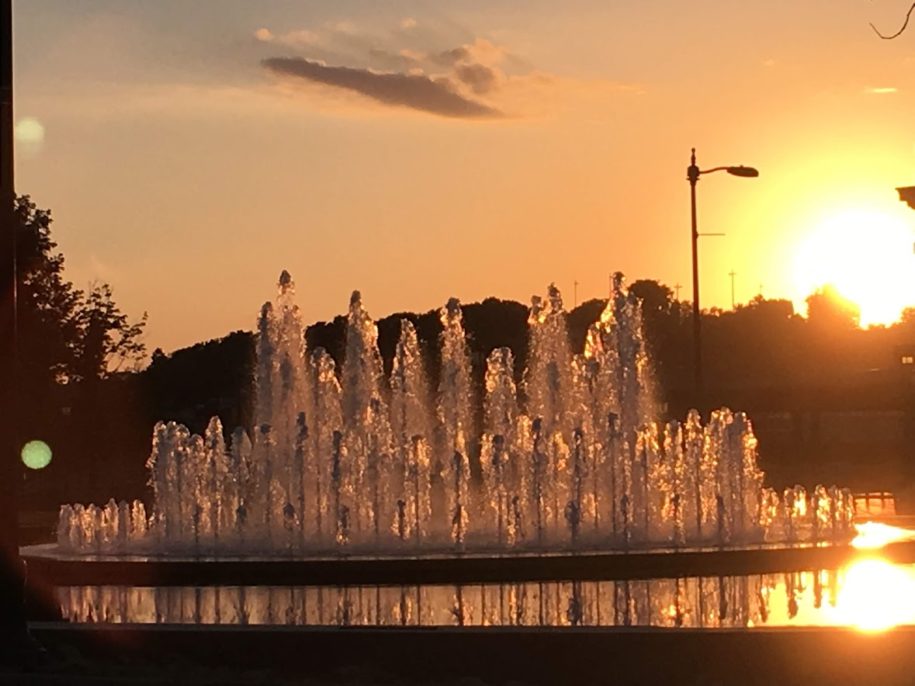by Asia Jones
There’s a reason Kansas City is called “The City of Fountains.” It has over 200 fountains, second only to Rome! Besides being visually stunning, these water features have a lot of historical and cultural significance.
One of the first places you’ll see a fountain is on the City of Kansas City, Missouri seal. It was designed by Patrice Eilts Jobe under then-Mayor Emmanuel Cleaver II. It had to symbolize a city moving forward into the next century. In the logo, Jobe used blue for the fountains and fuchsia for Kansas City’s warm personality. The city council approved the seal unanimously and for 25-plus years it has been the official city logo. Watch this video to hear the complete story and the amount that Kansas City paid for the logo.
Read more about the fountains that inspired this logo and some cool ones to visit around town. You can explore local history, our city’s architectural wonders, and fun things to do.
Liberty Memorial Fountain
You can see the Liberty Memorial North Fountains up close during our Crossroads Art District & Westside Urban Hike. The Liberty Memorial complex was built between 1923 and 1938. Found just under the Great Frieze, the fountains were built in 1935 as part of the original complex and are still just as beautiful today. As the decades passed, the Liberty Memorial fell into disrepair. In 2002, the site reopened after being renovated in the early 2000s. However, the fountains were rehabilitated from 2011-2015 by Gould Evans Architecture (theclio.org). Visitors to the structure have noted words carved above each fountain that honor those who died during the war.
One other cool piece of information, is that this breathtaking fountain was constructed by Wight and Wight, an architectural firm owned by the Wight brothers responsible for constructing dozens of notable structures in Kansas City including the Nelson-Atkins Museum of Art, Wyandotte County, Kansas Courthouse, and the Kansas Governor’s Mansion. Kansas City’s history is amazing, and the more you learn, the more it all makes sense!
Observation Park Fountain
Though not currently operational, this fountain’s beautiful design is still worth seeing and is another stop on the Crossroads Art District & Westside Urban Hike. Found in Observation Park by the intersection of Holly Street and 20th Street, the fountain was designed by John Van Brunt, brother of Adriance Van Brunt, the namesake of Van Brunt Boulevard. The wall fountain, originally used for horses to drink from, is shaped like a lion’s head and is surrounded by ornate floral details.
Neptune Fountain
This fall, you can see the Neptune Fountain up close when our Plaza Lights & Crestwood Urban Hike resumes. In 1911, the Bromsgrove Guild of Applied Arts created the Neptune Fountain in Worchester, England. It depicts the Roman god of the seas and made its way overseas to Pennsylvania in the same year to a locomotive company president who kept the fountain until his death. The fountain was up for sale as scrap metal and sold to The Nichols Company in the 1930s. They installed it in 1953. Now on the patio of Made In KC Marketplace on the Plaza at 47th Street and Wornall Road, it’s still a distinct attraction for the city.
Fountain in Mill Creek Park
Formerly called the J.C. Nichols fountain, the fountain sits at Emanuel Cleaver II Blvd and Mill Creek Pkwy. Henri-Léon Gréber sculpted the figures in 1910 and they were installed in Kansas City in 1960. Four heroic horsemen represent four of the world’s mighty rivers: the Mississippi River (fending off an alligator), the Volga River (with the bear), the Seine and the Rhine. In addition, there are four smaller dolphin-like figures playing on fish.
In June 2020, the Parks and Recreation Commissioners voted to remove Nichols’ name from the fountain, which we talk about much more in depth on our Plaza Lights & Crestwood Urban Hike.
Make a plan to learn more about our city’s fountains and history this month! You can schedule your next adventure here.

